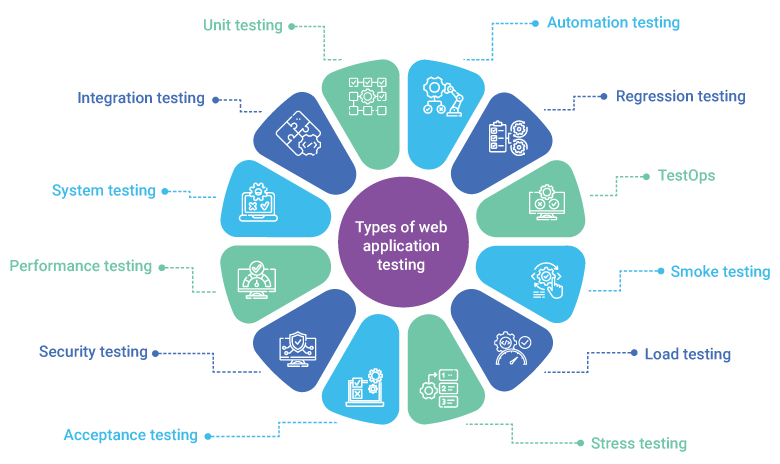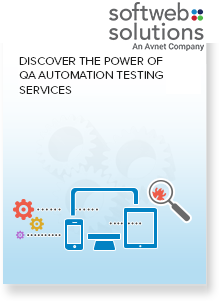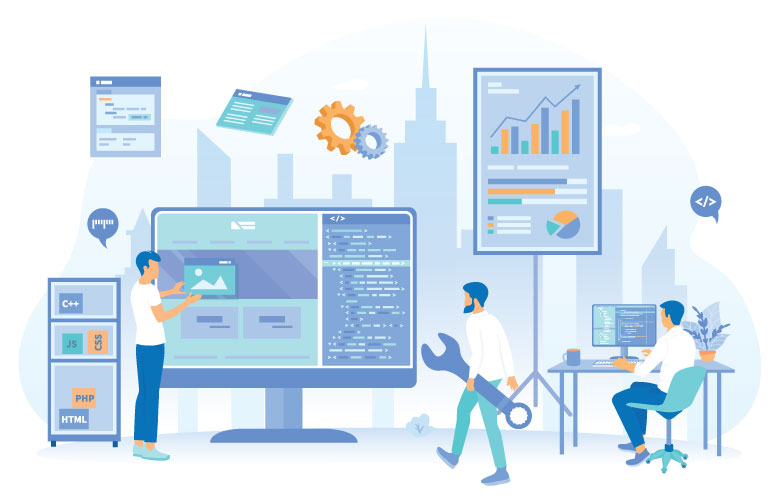The success of your web application can be the linchpin of your business’s growth trajectory. Today’s modern business must not merely rely on functionality, but also on exceptional user experience, driving engagement and building customer loyalty.
According to IBM, the cost to fix bugs found during the testing phase could be 15x more than the cost of fixing those found during design.
As businesses increasingly rely on sophisticated web platforms to connect with their audiences, web application testing emerges as a strategic imperative. This blog delves into the transformative impact of web application testing services. Let’s explore different types of web application testing.
Understanding web application testing and why it is necessary
Web application testing is essential for ensuring its functions are accurate and meet the requirements of end users. To understand the testing process precisely, here is a comprehensive breakdown:
- Purpose of web application testing
It aims to identify bugs, ensure functionality, and verify that the application meets the specific requirements. It ensures the application:
- Functions correctly across different browsers and devices
- Performs well under varying loads
- Secure against vulnerabilities
- Provides good user experience
- Number of end users
It involves assessing how the application:
- Handles high volume of users
- Robustness under extreme conditions
- Ability to scale efficiently with user demands
- Target domain
- Domain-specific testing: Based on target domains such as e-commerce, banking, healthcare, etc., it assures specific regulations and compliance requirements are met. Therefore, testing ensures that domain-specific functions such as payment processing and data security are working correctly and adhere to relevant standards.
- Functional testing: It validates that all features and functions are relevant to the target domain and work as expected.
- User role
- Role-based testing: Various users have different login permissions and roles within an application, for example admin, regular user, and guests. Testing ensures that each role has appropriate access and functionalities, and unauthorized users do not have permission to access restricted areas.
- User authentication and authorization testing: Verifies user authentication such as login mechanism and authorization such as role-based access control is working accurately.

Importance of AI in software testing
AI in software testing improves software quality by analyzing data and identifying patterns. It optimizes the testing process, automates repetitive tasks, and analyzes vast datasets efficiently for more reliable software solutions.
Further, web application testing is described in detail below:

Unit testing
It is a software testing method where the smallest part of an application such as units or components are tested in isolation from the rest of the system. These units are individual functions, methods, or classes validating each unit’s performance.
In 2023, unit testing used in 63% of all software projects was the most common type of software test. – Statista
For example:
Consider an online shopping cart
Add items to the cart:
- Test adding a single item to the cart to verify it appears correctly.
- Test adding multiple items to ensure the cart updates accurately.
- Test adding items with various quantities to check the cart reflects the correct total.
Tools for unit testing:
|
JUnit |
A widely used testing framework for Java applications. |
|
NUnit |
A robust testing framework for .NET applications. |
|
Jest |
A popular JavaScript testing framework. |
|
PyTest |
A flexible and scalable testing framework for Python. |
Integration testing
It combines multiple units, modules, and components of software applications for testing and ensures communication and data flow functions are consistent as a cohesive unit. Its goal is to identify issues in the interaction between integrated components.
For example:
Consider an event registration system
User registration and event enrollment:
- Verify user details are correctly passed from the registration module to the event enrollment system.
- Ensure users can register, view their details, and successfully enroll in events.
Payment processing and confirmation:
- Confirm the payment module securely processes transactions and confirms success.
- Test that after payment, the registration status is updated, and a confirmation email or notification is sent.
- Ensure errors during payment processing trigger appropriate messages and provide resolution instructions.
Tools for integration testing
|
JUnit |
Used for testing in Java applications. |
|
TestNG |
A Java testing framework with advanced configuration capabilities. |
|
Postman |
A tool for API integration testing to validate HTTP requests. |
|
SoapUI |
A tool used for testing of web services, particularly for SOAP and REST APIs. |
System testing
It is a comprehensive phase in the software testing lifecycle that evaluates the complete and integrated software system to ensure it meets specified requirements and functions as intended. This type of testing is conducted after integration testing and focuses on verifying the entire system’s behavior and performance in a unified environment.
For example:
Consider hotel reservation system
- Verify that the user interface allows users to search for available rooms based on their selected criteria (e.g., dates, location, room type).
- Test the booking form to ensure users can enter their details (name, contact information) and that the system displays accurate room availability and pricing information.
- Check that users receive confirmation of their booking with a summary of their reservation details once they complete the process.
Tools for system testing
|
Selenium |
A widely used tool for automating web application testing. |
|
Cypress |
An end-to-end testing framework designed for modern web applications. |
|
Playwright |
Open-source framework for end-to-end testing of web applications. |
Performance testing
Evaluate how a system performs under various conditions, focusing on how application meets user expectations for speed, reliability, and stability, especially under varying operational conditions.
- Assessing user experience under load: Evaluate how well the app maintains responsiveness and functionality when subjected to varying user loads and network speeds.
For example, test how the app performs when 5,000 users access it simultaneously under different network conditions.
- Determining peak performance limits: Identify the maximum number of concurrent users the app can handle while keeping the response time within 2 seconds.
For example, ensure the app remains performant with 7,500 active users.
- Evaluating performance on low-bandwidth connections: Test the app’s responsiveness and stability when accessed from a low-bandwidth network.
For example, 2G or slow 3G, to confirm that essential functionalities remain usable.
Tools for performance testing
|
Apache JMeter |
An open-source tool to simulate heavy loads on web applications. |
|
LoadRunner |
Predicts system behavior under varying loads. |
|
Gatling |
Open-source tool designed to test web applications and services. |
|
BlazeMeter |
A cloud-based tool that supports JMeter scripts. |
Security testing
It focuses on identifying vulnerabilities, weaknesses, and potential threats within an application or system. It aims to safeguard the applications from threats, ensuring compliance with security policies and protecting user data and system integrity, maintain user trust.
For example:
- Authentication verification: Test the strength and effectiveness of user login mechanisms and credential storage.
- Authorization checks: Ensure users have appropriate access rights and cannot access unauthorized areas or functions.
- Vulnerability scanning: Identify and assess potential security vulnerabilities, such as SQL injection or cross-site scripting (XSS).
- Penetration testing: Simulate attacks to identify weaknesses and test the system’s resilience against real-world threats.
Tools for security testing
|
OWASP ZAP (Zed Attack Proxy) |
Open-source tool for finding vulnerabilities in web applications. |
|
Burp Suite |
Comprehensive solution for web application security testing. |
Acceptance testing
It determines whether a software application meets the acceptance criteria of the end-users or stakeholders and ensures the system fulfills business requirements and satisfies user needs.
For example:
Consider shopping experience on an e-commerce website
User registration and login:
- Verify that new users can successfully register for an account by entering their personal information and receiving a confirmation email.
- Test that returning users can log in with their credentials and access their accounts without issues.
Product search and purchase:
- Ensure users can search for products using keywords or filters and view accurate search results.
- Test that users can select products, add them to their shopping cart, and proceed to checkout.
- Verify that users can enter shipping and payment information, apply discount codes, and complete the purchase.
Tools for acceptance testing
|
TestRail |
Used for test case management. |
|
Zephyr |
A robust test management solution for end-to-end test planning and execution. |
Suggested: Explore test automation with Healenium
Automation testing
Automation testing involves using specialized tools to execute pre-scripted tests on the application. This type of testing is useful for repetitive tasks, regression testing, and load testing.
For example:
- Efficiency: Speeds up the testing process by automating repetitive tasks.
- Consistency: Ensures consistent execution of test cases.
- Cost-effective: Reduces the manual effort involved, lowering costs in the long run.
Tools for automation testing
|
Selenium |
A widely used tool for automating web application testing. |
|
Cypress |
An end-to-end testing framework designed for modern web applications. |
|
Katalon Studio |
Supports web, API, mobile, and desktop applications. |
|
Appium |
An open-source tool for automating mobile applications. |
|
Robot Framework |
A versatile open-source framework supports various testing libraries and tools. |
|
Playwright |
Open-source framework for end-to-end testing of web applications. |
Regression testing
It ensures that recent changes or additions to an application have not adversely affected its existing functionality but involves re-running previously executed test cases verifying that new code changes, bug fixes, or enhancements have not introduced any new defects causing unintended side effects.
For example:
- Feature enhancements: Ensure new features such as a recommendation engine on an e-commerce site, don’t disrupt existing functions such as the shopping cart.
- Bug fixes: Verify fixing a bug, like in a banking app’s transaction history, doesn’t create new issues in other areas like transfers.
- Performance optimizations: Confirm performance improvements such as faster image loading on a social media platform without affecting the existing features.
- External system integration: Test integrating new systems or APIs such as email marketing tools in a CRM system, doesn’t disrupt current functionalities.
- System upgrades: Check application features such as content publishing in CMS remain functional after system upgrades.
Tools for regression testing
|
Selenium (with CI/CD tools like Jenkins) |
Integrates with CI/CD pipelines to automate web applications. |
|
TestComplete |
Supports functional, regression, and load testing for desktop, web, and mobile applications. |
|
Cypress |
A JavaScript end-to-end testing framework to automate browser interactions. |
|
Playwright |
A Node.js library that automates web tests across Chromium, Firefox, and WebKit. |

AI and ML are revolutionizing test automation
AI and ML are revolutionizing test automation by resolving UI issues, enhancing functional and performance testing, and minimizing unrealistic data risk. This transformative impact makes testing more accurate and reliable.
TestOps
TestOps is an emerging practice that integrates testing into the overall DevOps pipeline. It focuses on the management, orchestration, and analysis of testing activities across all phases of development. TestOps ensures that testing is aligned with continuous integration/continuous delivery (CI/CD) processes, enabling faster and more reliable releases.
Benefits of TestOps:
- Enhanced collaboration: Bridges the gap between development, operations, and testing teams.
- Continuous testing: Ensures that testing is a continuous activity integrated with the CI/CD pipeline.
- Improved quality and speed: Accelerates the release process while maintaining high quality.
Tools for TestOps
|
Jenkins |
CI/CD tool to automate the building, testing, and deployment of software. |
|
CircleCI |
A cloud-based CI/CD platform facilitates continuous integration and delivery workflows. |
|
Azure DevOps |
Provides a complete suite for end-to-end DevOps practices. |
|
Gitlab |
Integrated CI/CD functionality for managing the full DevOps lifecycle. |
Smoke testing
It is a preliminary level of software testing conducted to ensure that the most critical functions of an application are working correctly before more detailed testing is performed.
For example:
1. Build verification
Before extensive testing begins, smoke testing verifies that the latest build is stable enough for further testing. For example:
- E-commerce application: After deploying a new build, perform smoke testing to ensure that basic functions like login, product search, and checkout are working.
2. Feature release
When a new feature is added, smoke testing ensures that the new feature doesn’t break the existing core functionality. For example:
- Social media app: After introducing a new messaging feature, conduct smoke testing to confirm that existing features like posting updates and notifications still work.
Tools for smoke testing
|
Selenium |
Supports automated smoke testing for web applications. |
|
JUnit |
Widely used for Java applications. |
|
TestNG |
Framework for automated testing that can handle smoke tests. |
|
Cypress |
A JavaScript end-to-end testing to automate basic smoke test. |
|
Playwright |
A Node.js library that automates smoke tests across different browsers. |
Load testing
Type of performance testing designed to assess how a system performs under a specific and an expected load of users or transactions. The primary objective is to determine whether the system can handle the anticipated volume of traffic or data without issues.
For example:
- API performance: Test how an API handles 1,000 requests per minute to ensure it operates smoothly without errors or delays.
- Database efficiency: Evaluate the database’s performance with multiple concurrent queries to ensure response times stay within acceptable limits.
- Streaming services: Assess how a video streaming service manages 500 simultaneous HD streams to ensure quality and minimal buffering.
Tools for load testing
|
Apache JMeter |
Widely used for performance and load testing of applications. |
|
LoadRunner (Micro Focus) |
Enterprise-grade tool for load testing and performance monitoring. |
Stress testing
It evaluates how a system behaves under extreme or peak conditions beyond its normal operating limits. It determines the system’s robustness, identify breaking points, and assess its ability to recover from failure.
For example:
- System limits: Determine the maximum load the system can handle before failure, like handling 10,000 transactions per second.
- Resource exhaustion: Assess how the system behaves when resources like CPU, memory, or storage are maxed out.
- Error handling: Verify how the system manages and recovers from high-load scenarios that cause errors or crashes.
Tools for stress testing
|
Apache JMeter |
Widely used for performance and load testing of applications. |
|
LoadRunner (Micro Focus) |
Enterprise-grade tool for load testing and performance monitoring. |

Discover The Power of QA Automation Testing Services
Assurance testing. Before the application is made public or sent to the client, it needs to have addressed every issue and bug that might have crept in during the coding of the application. Delegating a dedicated engineer to perform manual tests can get cumbersome.
Conclusion
As we navigate the intricate landscape of digital transformation, the role of comprehensive web application testing becomes undeniably pivotal to steering business growth. Beyond safeguarding functionality and performance, meticulous testing cultivates a resilient foundation for user satisfaction and operational excellence.
By embracing a strategic approach to testing, businesses can unveil latent opportunities, mitigate risks, and enhance their competitive edge. Talk to our QA test engineers to discuss your requirements.









